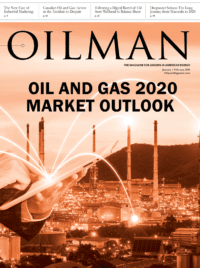In recent years, the oil and gas industry has experienced a major transformation in operations and oil production, with many companies now relying on data analytics and software to improve processes and pipeline efficiency. With an increased demand for big data, technologies, and upstream software solutions, many oil and gas operators are relying on software and data companies to provide the tools needed to satisfy various initiatives from gathering pipeline data, to minimizing operational risks and increasing safety.
With a heavy reliance on data and software solutions, companies who possess such expertise are in high demand. To stay ahead of the competition or to enhance and expand their software solutions, some oil and gas companies have established partnerships with software companies and vice versa, thus gaining the ability to provide an array of services to oil and gas customers. Engineering and procurement company, Worley, and software company, Arundo are two companies who have taken the opportunity to partner and strengthen their offerings. Together, the two companies have established the “Data Refinery,” a hub designed for applied data science and machine learning solutions in the energy, chemicals and resources industry.
Worley and Arundo’s “Data Refinery,” serves as a significant technological advancement for the oil and gas industry, and further builds on the expansion of software and technology use in the industry. Stuart Morstead, COO of Arundo shared how the Data Refinery “brings EPC relevant digital capabilities to our [Worley and Arundo’s] mutual global customers, including proprietary AI/ML software solutions, data science as a service, business-centric AI/ML education, and digital use case workshop facilitation.” Through his perspective, Morstead shared the capabilities of the Data Refinery, how partnerships and collaborations can benefit oil and gas customers, and how a digital transformation is promoting a positive change in the industry.
As the oil and gas industry increasingly depends more on upstream software solutions and data analytics to improve oil production, it is important that oil and gas operators and software companies stay up to date on their service offerings to continue benefiting their clientele. Aware of this demand, some companies have taken the initiative to build upon their services by collaborating or partnering with other companies. Morstead expressed the importance of companies partnering saying, “I do believe it is important for oil and gas companies to start working closer with software companies, especially in the ‘new normal’ environment where efficiency, reliability and visibility are key drivers on the bottom line.” Morstead’s software and analytics company, Arundo took the opportunity to partner with Worley, an engineering and energy consulting services company.
The two companies decided to partner after seeing how their differentiated services could help transform an industry and solve customer problems. “Worley and Arundo executives were introduced through a common relationship and quickly realized that their mutual capabilities could be a powerful combination to solve customer problems in an industrial context. Worley has deep subject matter expertise and strong customer relationships at the asset-level across the oil and gas value chain, and Arundo brings deep data science and machine learning expertise in the industrial context and proof of value in 90 days or less.” explain Morstead.
Since partnering, the two companies have been able to provide various services to their combined network of oil and gas customers, one in particular being the “Data Refinery,” located in “an iconic building in downtown Houston,” as Morstead described. “The Data Refinery has been serving as a global hub for numerous digital workshops, ideation sessions, data science educational programs, and digital team meetings. In addition to the capabilities we are bringing to the external market, it has been an integral part to boosting the “digital readiness” within Worley while being the center of development for data-centric products,” Morstead described.
Unlike a single technological tool that can be used by one or a few oil and gas customers, the Data Refinery serves a plethora of customers, especially those located in Houston. Morstead shared how “hundreds of industrial users now have access to the Data Refinery’s SaaS product DataSeer, which combines computer vision and machine learning to bring unprecedented speed and accuracy to project cost estimation work.” Through the use of the Data Refinery, many oil and gas operators will be able to better determine the cost of projects and make smarter decisions based on accurate data.
Oil and gas operators are increasingly relying on software solutions and data hubs, like the Data Refinery, to improve the efficiency of oil production and processes and to minimize risks and operational costs, among other issues. As Morstead explained, “Data science and analytics are being leveraged to improve operating uptime, asset life and HSE challenges. The ability to combine historical data sets and live data flows at scale is enabling operators to make better decisions that improve outcomes.” Morstead also expressed how “some of the solutions coming to market now are enabling organizations to move humans out of dangerous contexts (e.g., equipment inspection in inherently dangerous places) or to improve monitoring and avoidance of pollution emissions.” With an increased popularity for the use of big data and analytics in the oil and gas industry, collaborating with software companies, like Arundo, is almost a necessity to improve business operations and to continue contributing to the industry as a whole.
Through Worley and Arundo’s partnership, the two companies created DataSeer through the Data Refinery. Morstead explained how “DataSeer is a cloud-based machine learning application that extracts information (symbols and text) from engineering schematic diagrams like P&IDs by leveraging deep learning models along with computer vision techniques.” “Its most significant impact is the dramatic reduction in user workload and increased confidence and accuracy of extracted information from P&ID images. This is especially important for brownfield expansion engineering projects or during bid phases where P&IDs are not always available in CAD source formats but, instead, as raw scanned images,” Morstead expounded on the application’s benefits. Through their partnership, Worley and Arundo have been able to make significant contributions, not only to their clientele, but to the industry overall.
The two companies are also launching the DataSeer Managed Service, which is a “scalable, turnkey managed service leveraging the DataSeer application suite in combination with a rigorous engineering workflow to rapidly convert legacy engineering drawings into smart digital drawings of the highest quality,” Morstead shared. They expect to fully launch this offering in February 2020.
With the oil and gas industry undergoing a digital transformation, it is imperative that oil and gas operators remain—or become—up to date and improve their business operations to stay relevant and meet industry demands. With a push for big data and analytics to help monitor operational efficiency and examine project costs, for example, partnering with software companies to obtain access to such tools can help companies improve business outcomes and achieve growth. Worley and Arundo are two companies continuing to grow their business and designing digital solutions for their customers. “We are working on a number of data-driven solutions that are either process-centric or equipment-centric. These solutions can be applied to different parts of the oil and gas value chain from upstream production optimization to refinery workflow improvement. More to come in 2020,” stated Morstead.
Tonae’ Hamilton has been a contributor and associate editor to the magazine for two years. She has been writing professionally for almost four years. In her free time, Tonae’ likes to spend time with her three pets, cook, and binge-watch Netflix shows. Tonae' has a Bachelor of Arts in Communication from McDaniel College.










